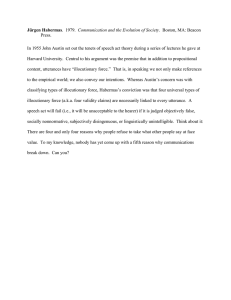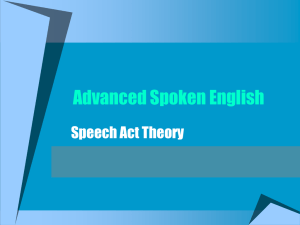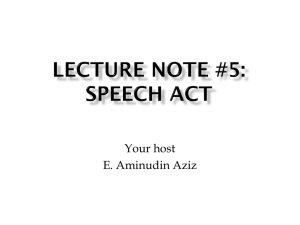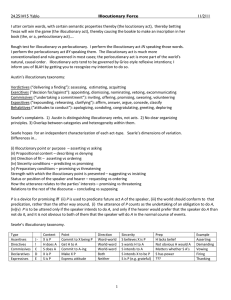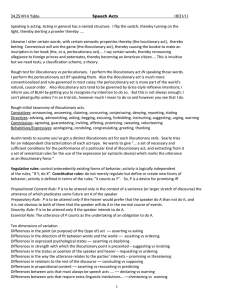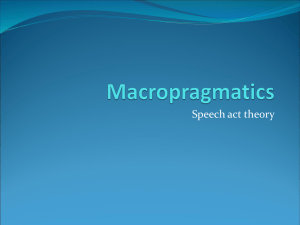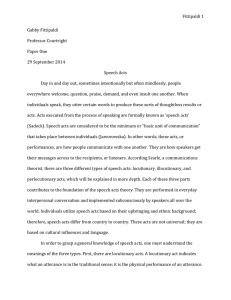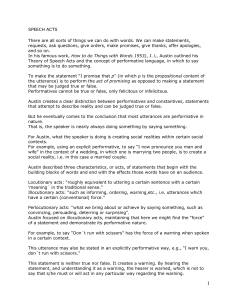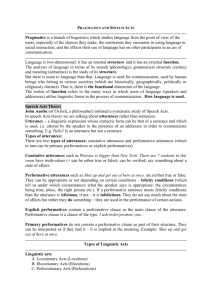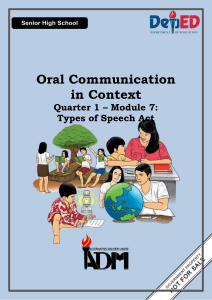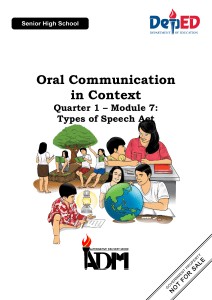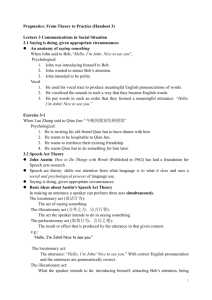What is a Speech Act by John Searle
advertisement
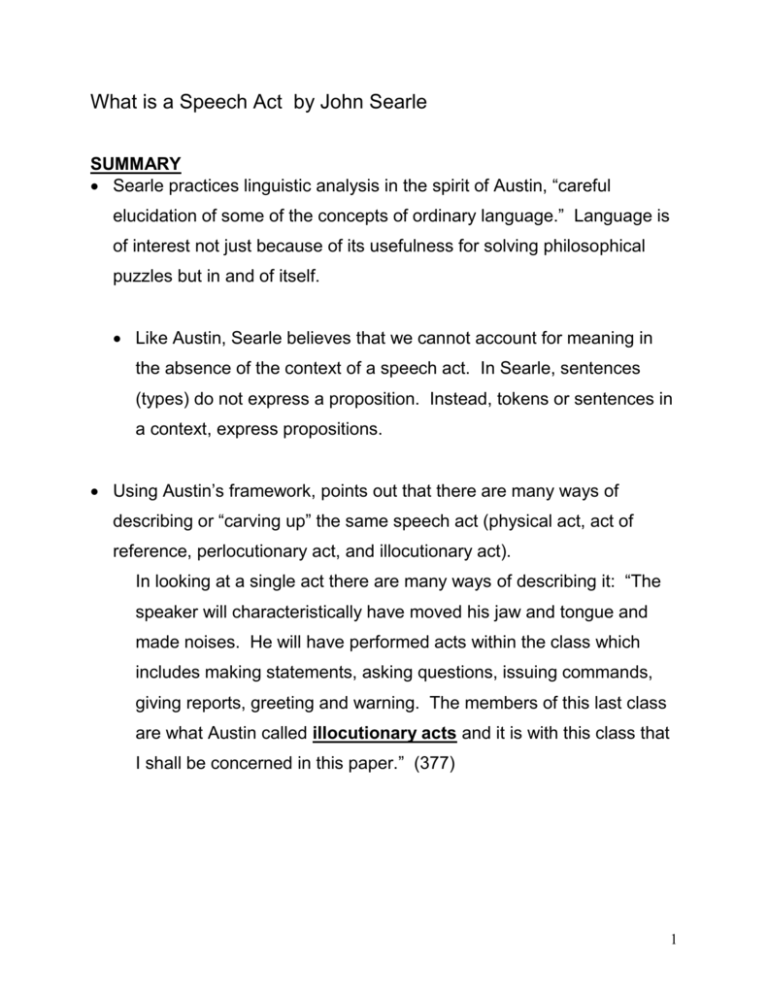
What is a Speech Act by John Searle SUMMARY Searle practices linguistic analysis in the spirit of Austin, “careful elucidation of some of the concepts of ordinary language.” Language is of interest not just because of its usefulness for solving philosophical puzzles but in and of itself. Like Austin, Searle believes that we cannot account for meaning in the absence of the context of a speech act. In Searle, sentences (types) do not express a proposition. Instead, tokens or sentences in a context, express propositions. Using Austin’s framework, points out that there are many ways of describing or “carving up” the same speech act (physical act, act of reference, perlocutionary act, and illocutionary act). In looking at a single act there are many ways of describing it: “The speaker will characteristically have moved his jaw and tongue and made noises. He will have performed acts within the class which includes making statements, asking questions, issuing commands, giving reports, greeting and warning. The members of this last class are what Austin called illocutionary acts and it is with this class that I shall be concerned in this paper.” (377) 1 For Searle the basic unit of language is the speech act or illocutionary act, the production of a token in the context of a speech act (not the word, the sentence type, or the theory). For a token to be an instance of communication, the audience must take it as being produced by a being with certain intentions (relevance of speaker intention, in contrast to Russell or Frege or logical positivism). Introduces and defines the notion of a proposition as the common content of various expressions such as (380) 1. Will John leave the room? 2. John will leave the room. 3. John, leave the room. Distinguishes between the notion of a proposition and that of an assertion: “An assertion is an illocutionary act, but a proposition is not an act at all, although the act of expressing a proposition is part of performing certain illocutionary acts.” (381) Argues for the main thesis that to perform an illocutionary act is to primarily to do (rather than to say) and to engage in rule-governed behavior. (378) 2 Responds to Austin’s call for a general theory of speech acts, producing a theory of speech acts in which speech acts are analyzed in terms of schemas. For example, a speaker S makes a promise (acts out a certain illocutionary act) if and only if (1) he utters an expression E where E is a device for promising and (2) the felicity conditions for promising obtain. To explain the notion of meaning, introduces the notion of semantical rules that govern the use of expressions and distinguishes two types: regulative and constitutive. “The hypothesis that lies behind the present paper is that the semantics of a language an be regarded as a series of systems of constitutive rules and that illocutionary acts are performed in accordance with these sets of constitutive rules.” (380) Intends to explicate the notion of an illocutionary act by (1) stating a set of necessary and sufficient conditions for the performance of a particular kind of illocutionary act, and (2) extracting from it a set of semantical rules of the use of the expression (378). Describes a (Gricean) theory of meaning that takes into account speaker intention. (382) To say that a speaker meant something by X is to say that the speaker intended the utterance of X to produce some effect in the audience by means of the recognition of this intention. 3 Evaluates Grice’s definition as beneficial in that it points of the role of speaker intention but as deficient in that it ignores the role of convention. “It fails to distinguish the different kinds of effects – perlocutionary versus illocutionary – that one may intend to produce in one’s hearers, and it further fails to show the way in which these different kinds of effects are related to the notion of meaning.” (383) An American soldier addresses the Italian captors with “Kennst du as Land, wo die Zitronen bluhen? Gricean effect: persuading them I am a German soldier (perlocutionary) through the recognition of my intention to do so. But it doesn’t follow that what I mean is that I am a German soldier when I say “Do you know the land where the lemon trees bloom?” “what we can mean is a function of what we are saying, it is also a matter of convention.” (384) Amends Grice’s definition to take into account the role of convention, as well as intention. (384) To say that a speaker meant something by X in the performance of a certain illocutionary act is to say that the speaker intended the utterance of X to produce some effect in the audience by means of the recognition of this intention and furthermore, if he is using the words literally, he intends this recognition to be achieved in virtue of the fact that the rules for using the expressions he utters associate the expressions with the production of that effect. (384) 4 Gives an analysis of promising, providing its rules or set of necessary and sufficient conditions. (1) Normal input and output conditions obtain (same language, conscious, not under duress. (2) S expresses that p in the utterance of T. (3) In expressing that p, S predicates a future act A of S. (4) H would prefer S’s doing A to his not doing A, and S believes H would prefer his doing A to his not doing A. (5) It is not obvious to both S and H that S will do A in the normal course of events. (6) S intends to do A. (Ammended: S intends that the utterance of T will make him responsible for intending to do A.) (7) S intends that the utterance of T will place him under an obligation to do A. (8) S intends that the utterance of T will produce in H a belief that conditions (6) and (7) obtain by means of the recognition of the intention to produce that belief, and he intends this recognition to be achieved by means of the recognition of the sentence as one conventionally used to produce such beliefs. (9) The semantic rules of the dialect spoken by S and H are such that T is correctly and sincerely uttered if and only if conditions (1) – (8) obtain. Derives rules to govern the use of the function-indicating device “promise” 5 (1) Rule 1: P is to be uttered only in the context of a sentence (or large stretch of discourse) the utterance of which predicates some future act A of the speaker S. (2) Rule 2: P is to be uttered only if the hearer H would prefer S’s doing A to his not doing A, and S believes H would prefer S’s doing A to his not doing A. (a preparatory rule) (3) Rule 3: P is to be uttered only if it is not obvious to both S and H that S will do A in the normal course of events. (a preparatory rule) (4) Rule 4: P is to be uttered only if S intends to do A. (the sincerity rule) (5) Rule 5: The utterance of P counts as the undertaking of an obligation to do A. (the essential rule) 6 7
